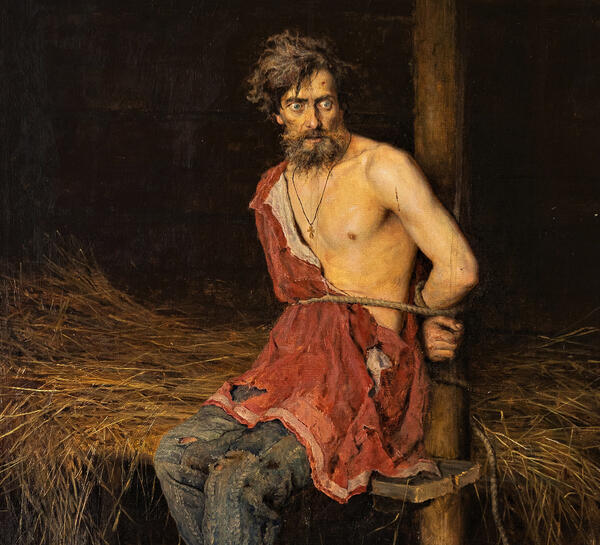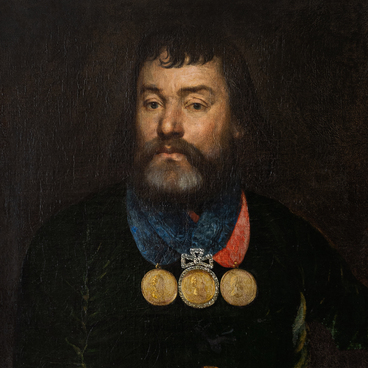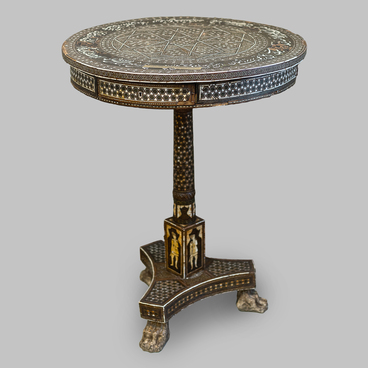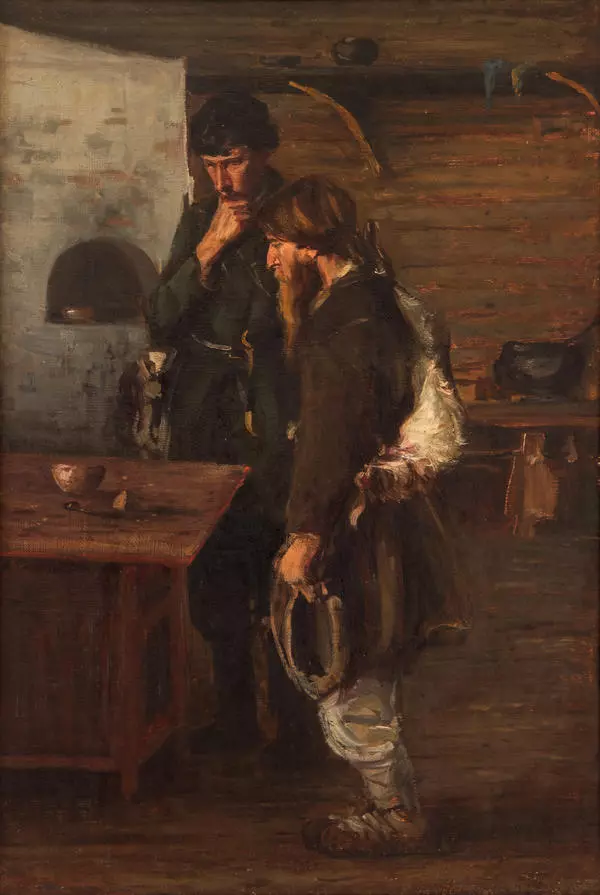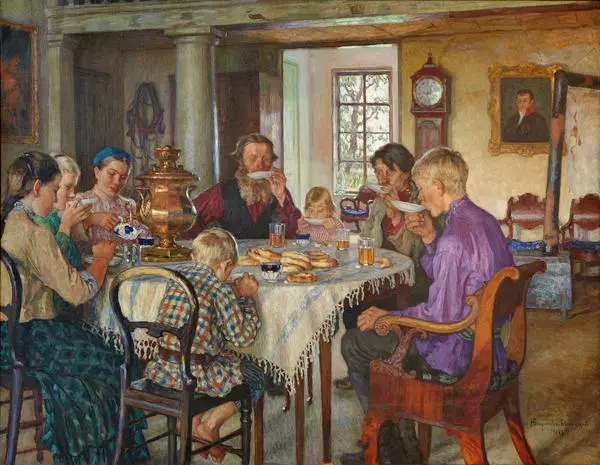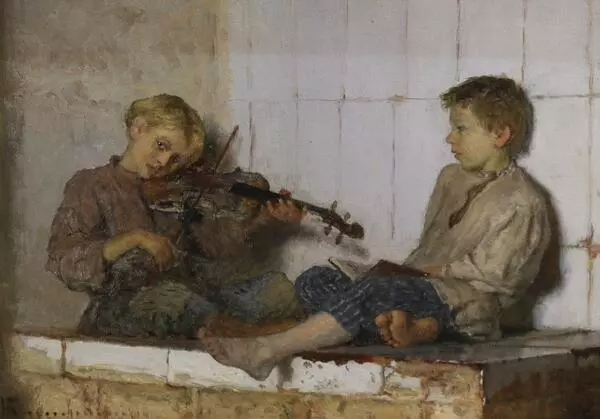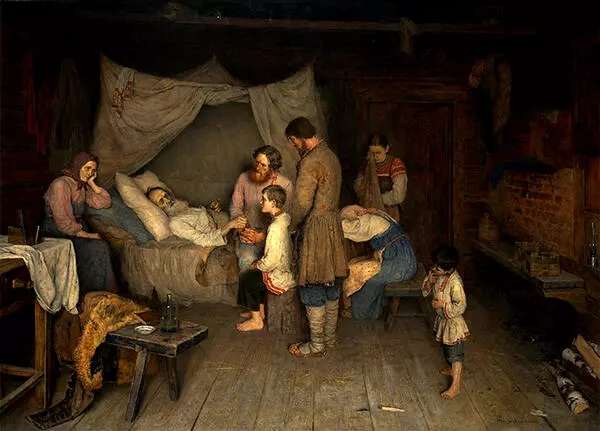The artist Nikolay Bogdanov-Belsky painted the picture ‘A Madman’ in the second half of the 19th century. He portrayed a middle-aged peasant bound after a fit of madness, barefoot, wearing a simple shirt and a pair of trousers.
The man sits in a windowless shed on wooden planks, his hands bound behind his back with a rope and tied to a post. The straw bedding is partly scattered on the floor, the shirt is torn, scratches are visible on the man’s body. Judging by these signs, during a fit of insanity, the man was seized, immobilized after a scuffle, tied up, and left alone.
Psychiatry developed in Russia as slowly as in European countries. From the second half of the 19th century, the country began to build the first state district hospitals for the mentally ill. During the reforms of Alexander II in the 1860s, the treatment of such patients was gradually transferred to local governments. Provincial and district, zemstvo and city hospitals, psychiatric departments of simple hospitals, and outpatient clinics appeared in public psychiatry.
However, due to the lack of knowledge about mental illnesses, these institutions rather resembled shelters with controversial treatment methods: chains, straitjackets, affusions, nux vomica (emetics), laxatives, and isolation.
In 1862, the humanist and professor of psychiatry Alexander Frese in his book “On the construction of homes for the insane” wrote that a mentally ill person, often not recognizing the power of laws, is ready to break them “to carry out their unrealizable plans and make their wild desires come true.” As a result, the patient could become a criminal by committing atrocities (murder, arson, etc.) but at the same time should not be considered guilty, as they could not distinguish between good and evil. Nevertheless, such personality changes required immediate “removal from the world of healthy people.”
Peasants could count on help in the main zemstvo psychiatric hospital, but they often had to cope with the problem on their own or with the help of a village doctor.
Nikolay Bogdanov-Belsky was born in 1868 in the Smolensk province and belonged to the group of the Peredvizhniki (the Itinerants) artists. He was the illegitimate son of a farm laborer, receiving his first surname at baptism and later taking the second one in honor of his native district of Belsky.
Bogdanov-Belsky studied at the icon-painting workshop of the Trinity Lavra of St. Sergius, and in 1884, he entered the Moscow School of Painting, Sculpture, and Architecture. From 1894 to 1895, he studied under Ilya Repin at the Academy of Arts and then left for Paris. In 1905, Bogdanov-Belsky was awarded the title of academician, and in 1914, he became a full member of the Academy of Arts.
Bogdanov-Belsky was a member of the Association of Itinerants and chairman of the Kuindzhi Society. He created mainly genre paintings, most often dedicated to the school life of peasant children, as well as portraits and landscape sketches.
In 1920, Bogdanov-Belsky moved to Latvia, where he lived for 23 years. In 1944, he fell seriously ill and went to Berlin for surgery. The artist passed away on February 19, 1945. Bogdanov-Belsky was buried in Berlin at the Tegel Russian Orthodox Cemetery.
The man sits in a windowless shed on wooden planks, his hands bound behind his back with a rope and tied to a post. The straw bedding is partly scattered on the floor, the shirt is torn, scratches are visible on the man’s body. Judging by these signs, during a fit of insanity, the man was seized, immobilized after a scuffle, tied up, and left alone.
Psychiatry developed in Russia as slowly as in European countries. From the second half of the 19th century, the country began to build the first state district hospitals for the mentally ill. During the reforms of Alexander II in the 1860s, the treatment of such patients was gradually transferred to local governments. Provincial and district, zemstvo and city hospitals, psychiatric departments of simple hospitals, and outpatient clinics appeared in public psychiatry.
However, due to the lack of knowledge about mental illnesses, these institutions rather resembled shelters with controversial treatment methods: chains, straitjackets, affusions, nux vomica (emetics), laxatives, and isolation.
In 1862, the humanist and professor of psychiatry Alexander Frese in his book “On the construction of homes for the insane” wrote that a mentally ill person, often not recognizing the power of laws, is ready to break them “to carry out their unrealizable plans and make their wild desires come true.” As a result, the patient could become a criminal by committing atrocities (murder, arson, etc.) but at the same time should not be considered guilty, as they could not distinguish between good and evil. Nevertheless, such personality changes required immediate “removal from the world of healthy people.”
Peasants could count on help in the main zemstvo psychiatric hospital, but they often had to cope with the problem on their own or with the help of a village doctor.
Nikolay Bogdanov-Belsky was born in 1868 in the Smolensk province and belonged to the group of the Peredvizhniki (the Itinerants) artists. He was the illegitimate son of a farm laborer, receiving his first surname at baptism and later taking the second one in honor of his native district of Belsky.
Bogdanov-Belsky studied at the icon-painting workshop of the Trinity Lavra of St. Sergius, and in 1884, he entered the Moscow School of Painting, Sculpture, and Architecture. From 1894 to 1895, he studied under Ilya Repin at the Academy of Arts and then left for Paris. In 1905, Bogdanov-Belsky was awarded the title of academician, and in 1914, he became a full member of the Academy of Arts.
Bogdanov-Belsky was a member of the Association of Itinerants and chairman of the Kuindzhi Society. He created mainly genre paintings, most often dedicated to the school life of peasant children, as well as portraits and landscape sketches.
In 1920, Bogdanov-Belsky moved to Latvia, where he lived for 23 years. In 1944, he fell seriously ill and went to Berlin for surgery. The artist passed away on February 19, 1945. Bogdanov-Belsky was buried in Berlin at the Tegel Russian Orthodox Cemetery.

